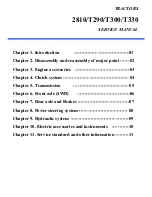
• Rear-view mirror.
• Fire extinguisher.
• Warning triangle, guards, back-up alarm, lighting and additional safety decals
It is very important to know how to use the tractor's safety devices. Make sure that they are in place and in
good condition. Do not remove or unplug any safety device.
1.4.4 Check the equipment
Before you begin the working day, take time to
inspect your tractor and ensure that all systems
are in good operating condition.
• Do not smoke when refilling the tractor. Keep
away from open flame.
• Shut off the engine and wait for it to cool
before refilling the tractor.
• Check for damaged, broken, loose or missing
parts. Always keep the parts in good condition.
Make sure that all guards and covers are in
place.
• Check the safety belt for damage. If the belt is
damaged, it must be replaced.
Fig. 7
• Make sure that the implements and accessories are properly installed and that the rotation of the
tractor PTO and the implement are in agreement.
• Check the tire pressure and condition (absence of cuts and bulges). Replace damaged or worn tires.
Make sure that the parking brake and pedal are functioning properly. Adjust them if necessary.
• Check the oil level and add oil, if necessary.
• Make sure that the PTO shaft safety devices are locked. Perform all servicing procedures described in
the Maintenance section of this Guide.
• Make sure that the PTO shield and shaft guards are in place and functioning properly.
• Check the hydraulic system of the implement and tractor. Repair or replace damaged or missing parts.
CAUTION:
The release of hydraulic fluid or diesel
fuel under pressure can penetrate the
skin and cause serious injuries,
blindness or death. Fluid leaks, under
pressure, may not be visible. Use a
piece of cardboard or wood to find
the leaks. Do not use your hands
directly. Always wear protective
goggles. If the fluid penetrates the
skin, it must be surgically removed
within a few hours by a doctor who is
familiar with this type of procedure
Fig. 8
Before applying pressure to the fuel or hydraulic system, make sure that all connections are tight and that
all tubing, tubes and hoses are not damaged. Relive all pressure before disconnecting the hydraulic or fuel
tubing. Make sure that all the hydraulic tubing is correctly installed and uncrossed.
CAUTION:
The coolant systems accumulate pressure as the engine warms up. Before removing the
radiator cap, shut down the engine and wait for the system to cool.
Check the engine cooling system and add coolant if necessary.
1. Safety
18
Series BM
87659000







































